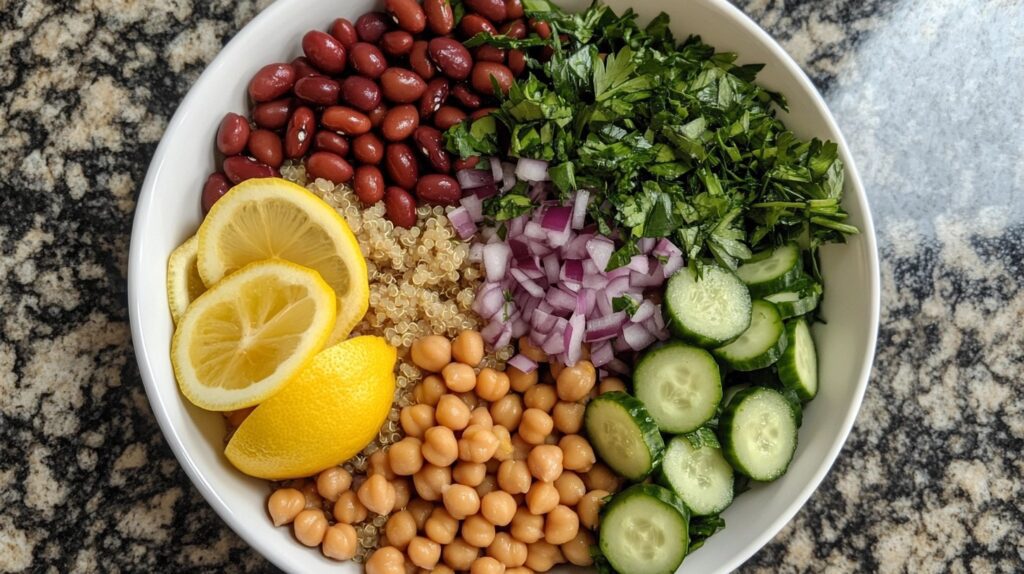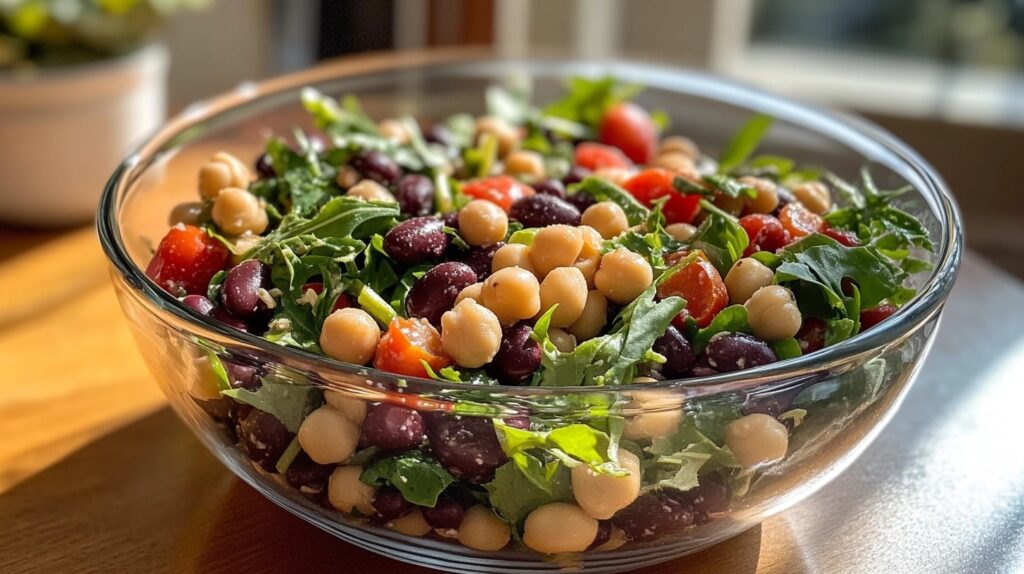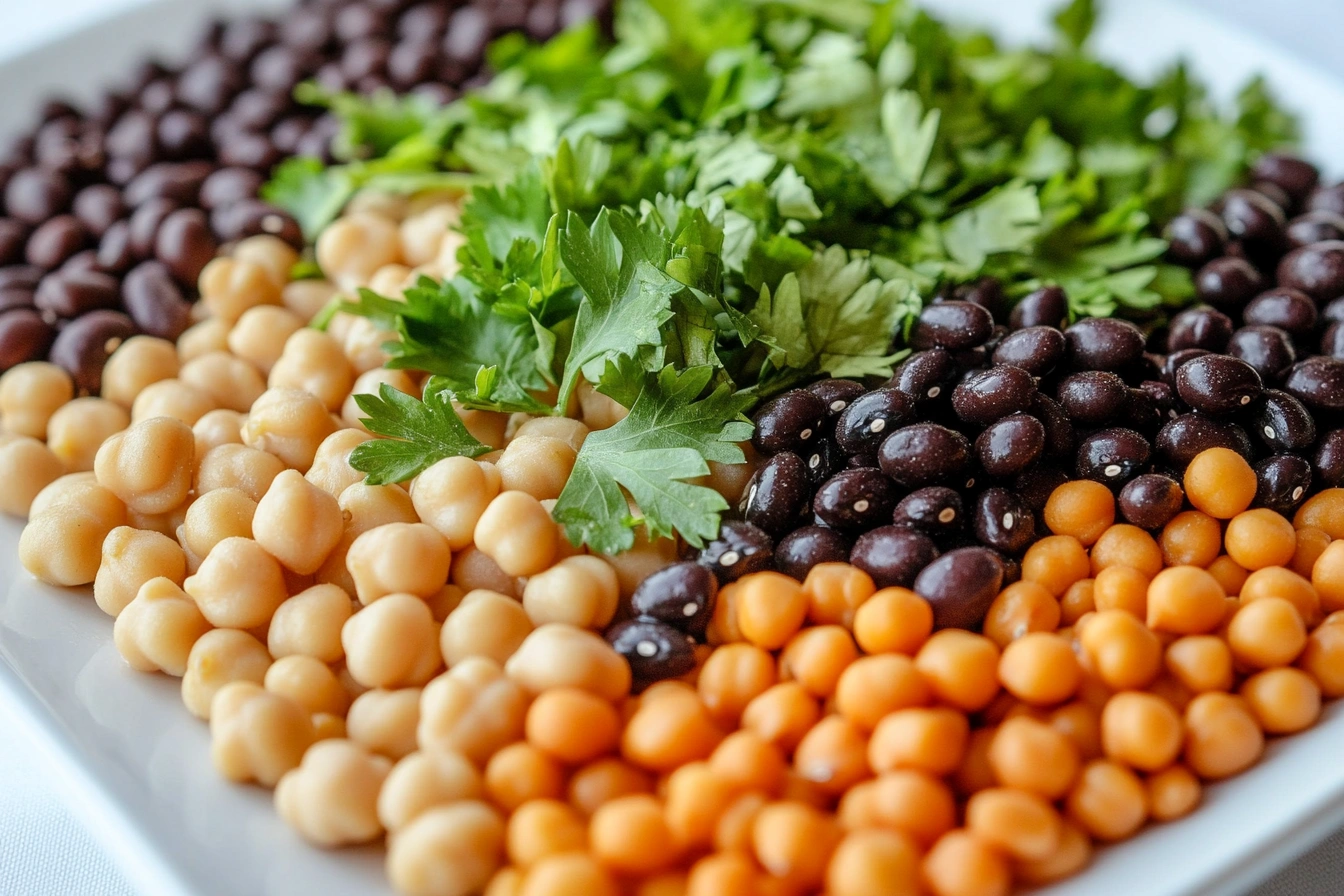Introduction
Beans are not just another ingredient; they’re nutritional powerhouses that can elevate any salad to a whole new level of taste and health. Whether you’re looking to boost protein intake, add fiber, or simply create a filling meal, the right beans can make all the difference. This article explores the healthiest beans for salads, why they matter, how to prepare them, and creative recipes that showcase their versatility. Let’s dive into the bean bowl and learn how to make salads more exciting!
Why Include Beans in Salads?
Nutritional Benefits of Beans in Salads
Beans are a nutrient-packed addition to salads, offering a wealth of vitamins, minerals, and macronutrients. For instance, they’re excellent sources of plant-based protein, making them ideal for those following vegetarian or vegan diets. With their high fiber content, beans promote digestive health and help you feel fuller longer, which is great for weight management.
Adding beans like black beans or kidney beans to salads also contributes to better heart health. These legumes are naturally low in fat and cholesterol but rich in folate, potassium, and magnesium—nutrients linked to reduced blood pressure and improved cardiovascular health.
Why Beans Are a Versatile Salad Ingredient
What makes beans stand out is their adaptability. They absorb flavors wonderfully, complementing a wide array of dressings and ingredients. Tossing in chickpeas or edamame not only adds a delightful texture but also blends seamlessly with fresh veggies, nuts, or even grains like quinoa.
For people who are always on the go, canned beans are a lifesaver. Simply rinse them, and they’re ready to toss into any salad. Plus, beans come in so many varieties—each with its unique taste and benefits—that you’ll never run out of options to keep your meals exciting.
Benefits for Weight Loss and Heart Health
Studies show that legumes like lentils and black beans help control blood sugar levels, making them perfect for those managing diabetes. Their low glycemic index means they provide steady energy without causing sugar spikes. And let’s not forget their role in heart health—beans can lower LDL cholesterol levels when consumed regularly.
If weight loss is your goal, beans are a must-have. Their high protein and fiber combo not only curbs hunger but also keeps you energized for hours. When added to salads, they transform a light meal into a satisfying one, keeping unhealthy snacking at bay.
Click here for more insights into the nutritional benefits of beans: Nutritional Benefits of Beans.
Types of Beans and Their Nutritional Profiles
Top Healthy Beans for Salads
Beans aren’t just a one-size-fits-all ingredient. Each type comes with its own nutritional profile and unique flavor, making it easy to customize your salads based on your needs. Let’s explore some of the healthiest beans for salads, so you can pick the best ones for your next recipe.
Black Beans: Rich in Antioxidants
Black beans are not only visually striking but also loaded with antioxidants like anthocyanins, which fight free radicals and support overall health. They’re an excellent source of plant-based protein and dietary fiber, making them perfect for heart health and digestion. With their slightly sweet and earthy flavor, black beans pair beautifully with corn, avocado, and zesty lime dressings in salads.
A half-cup serving of black beans provides:
- 114 calories
- 7.5g protein
- 5g fiber
- Rich amounts of folate and magnesium
Chickpeas: High in Protein and Fiber
Chickpeas, also known as garbanzo beans, are a beloved addition to Mediterranean salads. Packed with protein, they’re a great option for vegetarians and vegans. Chickpeas also offer a solid dose of complex carbohydrates, providing long-lasting energy without a sugar crash. They work especially well in salads with cucumbers, tomatoes, and a tahini-based dressing.
Nutritional benefits per half-cup of chickpeas:
- 134 calories
- 7g protein
- 6g fiber
- High in iron and manganese
Kidney Beans: Great for Iron and Potassium
Kidney beans earn their name from their signature shape, but their nutritional profile is equally notable. They’re an excellent source of iron, which is crucial for transporting oxygen in the blood, and potassium, which supports muscle function and hydration. Their slightly firm texture makes them ideal for salads with hearty greens like kale or spinach.
In just a half-cup of kidney beans, you’ll get:
- 113 calories
- 7.7g protein
- 6.5g fiber
- High levels of iron, potassium, and copper
Lentils: A Powerhouse of Nutrients
Lentils are among the most versatile legumes and deserve a top spot in your salad rotation. They come in various colors, including green, brown, and red, each offering a slightly different texture and taste. Lentils are rich in protein, fiber, and micronutrients like folate, which is essential for cell growth and repair.
A half-cup serving of cooked lentils contains:
- 115 calories
- 9g protein
- 8g fiber
- Abundant folate and magnesium
Edamame: Protein and Low-Calorie Content
Edamame, or young soybeans, are often enjoyed as a snack, but they’re just as good in salads. These vibrant green beans are low in calories but high in protein and essential amino acids. They’re an excellent option for individuals following a high-protein diet. Toss them with quinoa, sesame seeds, and a ginger-soy dressing for a refreshing salad twist.
Nutritional breakdown of a half-cup of shelled edamame:
- 120 calories
- 11g protein
- 4g fiber
- Packed with calcium and vitamin K
Cannellini Beans: Creamy Texture and Nutritional Benefits
Cannellini beans, also called white kidney beans, have a mild flavor and a creamy texture that blends seamlessly into salads. These beans are particularly high in potassium and magnesium, making them great for heart health and blood pressure regulation. Pair them with roasted vegetables or a tangy vinaigrette for a light yet filling salad.
Per half-cup of cannellini beans, you’ll get:
- 110 calories
- 8g protein
- 6g fiber
- High amounts of potassium and magnesium
How to Choose the Best Beans for Your Salad
Factors to Consider When Selecting Beans
Choosing the healthiest beans for salads goes beyond taste—nutrition, convenience, and quality also play crucial roles. To make the best choice, you’ll want to consider the following factors:
- Nutritional Needs: If you’re looking to increase protein, opt for high-protein beans like lentils or edamame. Need more fiber? Black beans and kidney beans are excellent choices.
- Flavor Profiles: Some beans, like chickpeas, have a mild flavor and work well with tangy dressings, while black beans and kidney beans provide an earthy richness.
- Texture Preferences: For creamier textures, cannellini beans are perfect. On the other hand, lentils and edamame add a slight crunch.
- Salad Ingredients: Pair beans with complementary ingredients. For example, edamame pairs wonderfully with Asian-inspired salads, while chickpeas shine in Mediterranean dishes.
Organic vs. Conventional Beans
When choosing beans, you may wonder whether to go organic or stick with conventional options. Organic beans are grown without synthetic pesticides and fertilizers, making them a healthier and more environmentally friendly choice. While they may be slightly more expensive, many argue the benefits are worth it, especially for canned beans, where non-organic varieties may have higher sodium content.
If you’re on a budget, conventional beans are still a fantastic option. Just make sure to rinse canned beans thoroughly to remove any excess salt or additives.
Dry Beans vs. Canned Beans
One of the biggest decisions you’ll face is whether to use dried or canned beans in your salads. Both options have their pros and cons:
| Feature | Dry Beans | Canned Beans |
|---|---|---|
| Preparation Time | Requires soaking and cooking | Ready to use after rinsing |
| Flavor and Texture | More robust and fresh | Slightly softer and saltier |
| Shelf Life | Longer when stored properly | Shorter shelf life |
| Nutritional Content | No added sodium | May contain added sodium |
| Cost | More affordable | Slightly more expensive |
For the best results, use dry beans when time allows, as they deliver superior flavor and texture. However, canned beans are incredibly convenient, especially for busy weeknights or last-minute salad prep.
Tips for Preparing Beans for Salads
How to Properly Cook and Store Beans
If you’re starting with dry beans, proper preparation is key to achieving great texture and flavor. Here’s how to do it:
- Soaking: Begin by soaking your beans. Overnight soaking is ideal, but if you’re short on time, a quick soak (boiling beans for two minutes, then letting them sit for an hour) works well too.
- Cooking: Simmer beans in a pot with plenty of water, adding a bay leaf or garlic clove for extra flavor. Cooking times vary—lentils cook in 20 minutes, while kidney beans may take up to 90 minutes.
- Storing: Cooked beans should be stored in an airtight container in the fridge for up to five days. For longer storage, freeze them in portions to save time later.
Rinsing and Draining Canned Beans
If you’re using canned beans, always rinse and drain them before adding them to your salad. This removes excess sodium and helps improve their taste. You can also soak them briefly in cold water to make them firmer and more appealing in texture.
Seasoning Beans to Complement Salads
Beans may seem plain on their own, but with a little seasoning, they become a standout ingredient. Toss your beans with olive oil, lemon juice, and a sprinkle of salt and pepper before adding them to your salad. For a spicy twist, try smoked paprika or chili powder. Fresh herbs like parsley, cilantro, or dill also enhance the flavor without overpowering the dish.
Healthy Salad Recipes Featuring Beans
Easy Salad Recipes with Beans
Incorporating the healthiest beans for salads into your meals is easier than you think. Whether you’re after something light and refreshing or hearty and filling, these recipes will inspire your next culinary creation.

Mediterranean Chickpea Salad
This vibrant salad combines the classic flavors of the Mediterranean with the hearty texture of chickpeas.
Ingredients:
- 1 can of chickpeas, rinsed and drained
- 1 cup cherry tomatoes, halved
- 1 cucumber, diced
- ¼ red onion, thinly sliced
- ½ cup Kalamata olives, pitted
- ¼ cup crumbled feta cheese (optional)
- 2 tbsp olive oil
- 1 tbsp red wine vinegar
- 1 tsp dried oregano
Instructions:
- In a large bowl, mix chickpeas, tomatoes, cucumber, onion, and olives.
- In a small bowl, whisk together olive oil, vinegar, and oregano.
- Pour the dressing over the salad and toss to combine.
- Top with crumbled feta (if using) and serve chilled.
Southwest Black Bean and Corn Salad
This zesty, protein-packed salad is perfect for summer picnics or as a side for tacos.
Ingredients:
- 1 can black beans, rinsed and drained
- 1 cup sweet corn (fresh or frozen)
- 1 red bell pepper, diced
- 1 avocado, diced
- ¼ cup chopped cilantro
- Juice of 1 lime
- 2 tbsp olive oil
- ½ tsp cumin
- Salt and pepper to taste
Instructions:
- Combine black beans, corn, bell pepper, and avocado in a bowl.
- Whisk lime juice, olive oil, cumin, salt, and pepper in a separate bowl.
- Pour the dressing over the salad and toss gently.
- Garnish with chopped cilantro and serve immediately.
Warm Lentil and Spinach Salad
For a comforting yet nutritious option, try this warm lentil salad packed with leafy greens and a tangy dressing.
Ingredients:
- 1 cup cooked green or brown lentils
- 2 cups fresh spinach leaves
- ½ red onion, thinly sliced
- 1 carrot, shredded
- 2 tbsp balsamic vinegar
- 1 tbsp Dijon mustard
- 2 tbsp olive oil
- Salt and pepper to taste
Instructions:
- Heat cooked lentils in a skillet over low heat until warm.
- In a large bowl, combine spinach, onion, and carrot.
- Whisk together balsamic vinegar, Dijon mustard, olive oil, salt, and pepper.
- Add warm lentils to the salad and drizzle with dressing. Toss and serve warm.
Edamame and Quinoa Salad

This high-protein salad is a great choice for meal prep or as a refreshing post-workout meal.
Ingredients:
- 1 cup cooked quinoa
- 1 cup shelled edamame
- ½ cup shredded carrots
- 1 green onion, sliced
- 2 tbsp soy sauce
- 1 tbsp sesame oil
- Juice of 1 lime
- 1 tsp sesame seeds
Instructions:
- In a bowl, combine quinoa, edamame, carrots, and green onion.
- Whisk together soy sauce, sesame oil, and lime juice in a small bowl.
- Pour the dressing over the salad and toss to combine.
- Sprinkle sesame seeds on top and serve.
These recipes prove that adding beans to salads can be fun, flavorful, and incredibly satisfying. Experiment with different combinations to find your personal favorite.
The Role of Beans in Specific Diets
Beans for Vegan and Vegetarian Diets
Beans are a cornerstone of vegan and vegetarian diets, providing essential nutrients that might otherwise come from animal-based sources. For starters, they are packed with plant-based protein, making them ideal for muscle repair and overall energy. Lentils, chickpeas, and black beans also supply a wealth of iron, a mineral that can be harder to obtain without meat.
Moreover, beans are rich in B vitamins, like folate, which supports brain health and cell regeneration. Their high fiber content promotes gut health, which is vital for optimal nutrient absorption. Combine these legumes with whole grains like quinoa or brown rice in salads to create a complete protein profile.
Paleo and Keto Considerations
The inclusion of beans in paleo and keto diets can be a bit controversial. Traditional paleo guidelines often exclude legumes due to their lectin and phytic acid content, but moderate consumption of properly prepared beans (soaked and cooked) may be acceptable for some followers.
For keto dieters, the main concern is the carbohydrate content of beans. While lentils and black beans are nutrient-dense, they also contain more carbs than typical keto-friendly foods. To incorporate beans into a keto plan, use them sparingly in salads with low-carb vegetables and healthy fats like avocado or olive oil. Edamame is an excellent option due to its lower carbohydrate profile.
Beans and Gluten-Free Diets
Beans are naturally gluten-free, making them a safe and nutritious choice for individuals with celiac disease or gluten sensitivities. In fact, they’re an excellent substitute for grains in salads, providing both texture and nutrients without the risk of gluten exposure.
For gluten-free meal prep, opt for naturally gluten-free dressings to accompany your bean salads. A simple vinaigrette made with olive oil, lemon juice, and Dijon mustard is a perfect pairing for a light, satisfying meal.
Common Questions About Beans in Salads
Are canned beans healthy for salads?
Yes, canned beans are a healthy and convenient option for salads. They retain most of their nutrients, including protein and fiber, and are ready to use. However, always rinse and drain them to reduce excess sodium and improve their flavor.
Which beans are highest in protein?
Lentils and edamame top the list when it comes to protein-rich beans. A single cup of cooked lentils contains about 18g of protein, while the same amount of edamame delivers roughly 17g. These options are fantastic for those looking to boost their protein intake.
Can beans cause digestive issues?
For some individuals, beans may lead to bloating or gas due to their high fiber and oligosaccharide content. Soaking beans overnight and cooking them thoroughly can reduce these effects. Gradually increasing your bean consumption allows your body to adjust over time.
What are the best ways to store cooked beans?
Cooked beans can be stored in an airtight container in the refrigerator for up to five days. For longer storage, freeze them in portion-sized containers or freezer bags. Just thaw and rinse them before use in salads.
Can beans help with weight loss?
Absolutely! Beans are low in calories but high in protein and fiber, which keeps you full for longer periods. Adding beans to salads can reduce unhealthy snacking and promote steady weight loss when combined with a balanced diet.
How can I make beans taste better in salads?
Season beans with herbs, spices, and a touch of acid (like lemon juice or vinegar) before adding them to your salad. This enhances their natural flavors and helps them blend seamlessly with other ingredients.
Conclusion
Choosing the Healthiest Beans for Your Salad
Adding beans to your salads is a simple, affordable, and delicious way to boost their nutritional value. From black beans and chickpeas to lentils and edamame, each bean type offers unique health benefits that can transform your meals. By selecting the right beans and preparing them thoughtfully, you’ll enjoy salads that are not only healthy but also full of flavor and texture. So, get creative with your ingredients and let these bean-based ideas inspire your next culinary masterpiece!


3 thoughts on “The Healthiest Beans to Add to Your Salad for Maximum Nutrition”